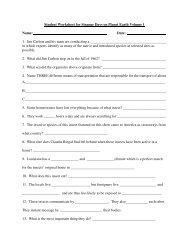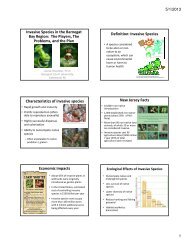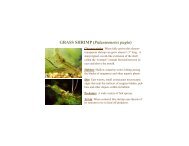Norway Maple (Acer platanoides) Japanese Barberry (Berberis ...
Norway Maple (Acer platanoides) Japanese Barberry (Berberis ...
Norway Maple (Acer platanoides) Japanese Barberry (Berberis ...
You also want an ePaper? Increase the reach of your titles
YUMPU automatically turns print PDFs into web optimized ePapers that Google loves.
Long Horn Beetle (Anoplophora glabripennis)<br />
Status: Invasive.<br />
Native to: Asia.<br />
Effects: This beetle is known to attack and kill at least<br />
18 species of hardwood trees including maple, birch,<br />
horse chestnut and elm.<br />
http://www.forestryimages.org/images/768x512/1148052.jpg<br />
http://www.cals.ncsu.edu/course/ent425/text18/asianlonghornedbeetle.jpg<br />
Distinctive features: The adult Long Horn beetle is<br />
over an inch in length, and is coal black in color with<br />
yellow or white spots. It also has distinctively long<br />
antennae with white bands. The female long horn beetle<br />
bores holes into the tree’s inner layers to lay her eggs,<br />
sealing the hole with digested sawdust called “frass”.<br />
When the eggs hatch, the larvae feed off of the tree’s<br />
nutrients until they are in the pupal stage. The pupae<br />
then chew their way out of the tree leaving<br />
characteristic, circular exit holes.<br />
Gypsy Moth (Lymantria dispar)<br />
Status: Invasive<br />
Native to: Europe and Asia<br />
Effects: Gypsy Moths defoliate the trees they infest.<br />
This removal of leaves weakens trees, leaving them<br />
more susceptible to disease. It can even kill trees if<br />
the same tree is infested repeatedly over several<br />
years. In the US, Gypsy moths defoliate over 1 million<br />
acres of forest a year.<br />
http://www.acgov.org/cda/awm/agprograms/images/mothsl<br />
arge.jpg upload.wikimedia.org/.../Lymantria_dispar01.jpg<br />
Distinctive features: Male gypsy moths are brown with<br />
a darker brown pattern on their wings. Females are<br />
slightly larger and nearly white, with a few dark<br />
markings on their wings. Newly hatched caterpillars are<br />
black and hairy, later developing a yellow to gray<br />
pattern with tufts of bristle-like hairs and subsequent<br />
rows of blue and red spots on their back.







